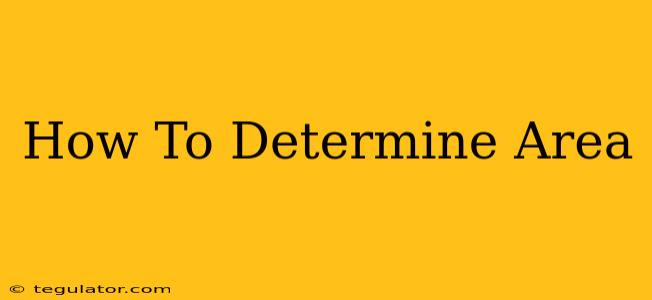Determining area is a fundamental concept in mathematics and has practical applications in various fields, from construction and design to land surveying and even everyday tasks like calculating the amount of paint needed for a room. Understanding how to calculate area, regardless of the shape, is a valuable skill. This guide will walk you through different methods for determining the area of various shapes.
Understanding Area
Before diving into the formulas, let's clarify what area actually means. Area is the amount of two-dimensional space inside a shape's boundaries. It's measured in square units, such as square inches, square centimeters, or square meters. The unit used depends on the scale of the measurement.
Calculating Area for Common Shapes
Here's a breakdown of how to calculate the area for some common geometric shapes:
1. Rectangle
The most straightforward shape! The area of a rectangle is found by multiplying its length by its width.
Formula: Area = Length × Width
Example: A rectangle with a length of 5 cm and a width of 3 cm has an area of 5 cm × 3 cm = 15 cm².
2. Square
A square is a special type of rectangle where all sides are equal. Therefore, the area is simply the side length squared.
Formula: Area = side × side or Area = side²
Example: A square with a side length of 4 inches has an area of 4 inches × 4 inches = 16 square inches.
3. Triangle
Triangles require a bit more information. You'll need the base (one side of the triangle) and the height (the perpendicular distance from the base to the opposite vertex).
Formula: Area = (1/2) × base × height
Example: A triangle with a base of 6 meters and a height of 4 meters has an area of (1/2) × 6 m × 4 m = 12 m².
4. Circle
Circles use the radius (the distance from the center to any point on the circle) or the diameter (twice the radius) in their area calculation. The constant π (pi), approximately 3.14159, is also involved.
Formula: Area = π × radius²
Example: A circle with a radius of 7 cm has an area of π × (7 cm)² ≈ 153.94 cm².
5. Irregular Shapes
Calculating the area of irregular shapes can be more challenging. One common method is to divide the shape into smaller, simpler shapes (like rectangles and triangles) whose areas you can calculate individually. Then, add the areas of the smaller shapes to find the total area of the irregular shape. Another method is to use integration in calculus if you have a mathematical description of the shape's boundary.
Practical Applications
Knowing how to determine area is crucial in many situations:
- Construction: Calculating the amount of materials needed for flooring, roofing, or painting.
- Real Estate: Determining the size of a property.
- Gardening: Planning garden layouts and calculating the amount of fertilizer or soil needed.
- Engineering: Designing and building structures.
Mastering Area Calculation
Practice makes perfect! Try calculating the areas of various objects around you – your tabletop, a window, or even a piece of paper. The more you practice, the more comfortable and confident you'll become with determining area. Remember to always include the appropriate square units in your answer. Understanding the fundamental concept of area and applying the appropriate formulas is key to success in this essential mathematical skill.

